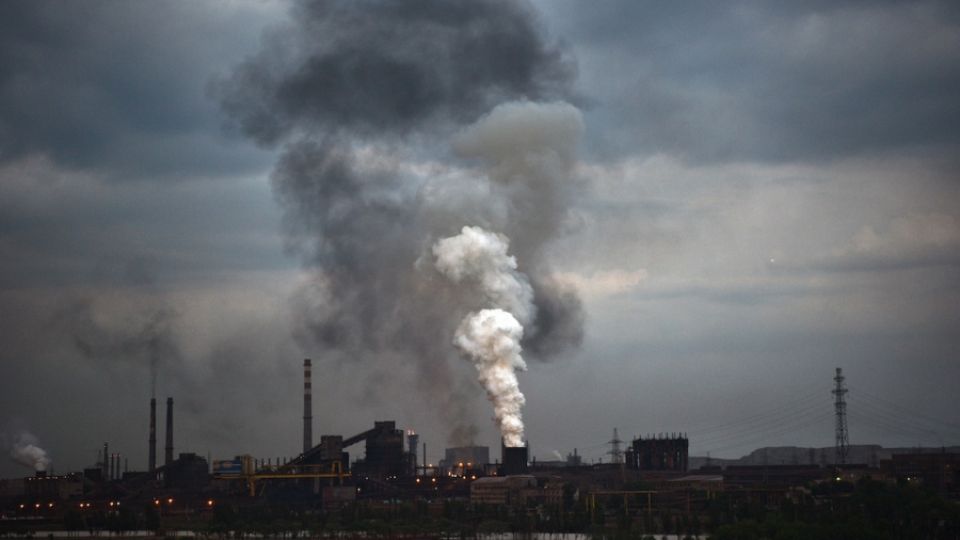Serious pollution of the air by toxic dust particles exceeding the WHO limits was confirmed in the Kryvyi Rih, Dnipro, Zaporizhia, and Donetsk urban areas. A unique study based on the satellite measurements of the European Space Agency and Copernicus Atmosphere Monitoring Service [1] was developed by the Czech start-up World from Space, together with the Arnika NGO within the Clean Air for Ukraine Project. In dozens of districts in the Dnipropetrovsk, Donetsk, Luhansk, and Zaporizhia regions and the capital city, Kyiv, the air can be considered dangerous for human health [2]. The main culprits are energy production and the metallurgical and other heavy industries.
“Satellites and ground sensors monitor dangerous air pollutants across the world. On the evidence of our data analysis, the Kryvbas and Donbas areas the most seriously polluted regions in Ukraine. In these places, heavy industry is most probably the cause of the problem. The city of Kyiv, another pollution hotspot in Ukraine, is also heavily affected by car traffic,” says Jan Labohy, the leading author of the research from the Czech start-up World from Space.
“It is a shame and sad that air pollution in Ukraine can be seen even from space. The main sources are obsolete technologies in coal power plants, metallurgy, mining, and processing. The satellite data confirms the citizens’ suspicions and the results of the EcoCity civic air monitoring,” says Maksym Soroka, an expert of the Clean Air for Ukraine Project and one of the co-authors of the research. “We hope that the state authorities, local government, and the industries will stop all attempts to deny this problem and start solving it – first of all, by using the best available techniques and up-to-date online monitoring systems,” Soroka adds.
“This study is not only a scientific confirmation of the results of civic air monitoring, but also another warning against the use of outdated industrial and mining technologies. Although Ukraine has adopted a number of new EU-style laws mainly during the last year, law enforcement is weak and residents do not yet see environmental improvements,” explains Pavlina Filippovova, Clean Air for Ukraine project coordinator from Arnika.
About 14,400 people die annually in Ukraine as a result of air pollution. According to the authors of the new research, public policies supporting improvements to air quality should focus on four main areas: improving air quality monitoring, supporting inventories of emissions and plans, conducting changes in management practices in key sectors, and involving the public in decision-making procedures.
The new study of World from Space follows research by the Prague University of Chemistry and Technology that confirmed contamination of river sediments, soil, and foodstuffs by air pollution [3]. Citizens can also sign a recently-launched petition for clean air here >>>
The key findings of the research were presented at the Industrial Air Pollution Ukraine 2020 conference – organized within the framework of the Clean Air for Ukraine project, led by the Czech NGO Arnika in cooperation with local civic initiatives in industrial towns of Ukraine, with financial support from the Transition Promotion Programme of the Ministry of Foreign Affairs of the Czech Republic and the National Endowment for Democracy (USA). The programme of the conference (every Tuesday until December 15th) and free registration are available here.
Notes:
[1] Full text of the study:
English:https://cleanair.org.ua/publication/air-pollution-in-ukraine-from-space/
Ukrainian:https://cleanair.org.ua/publication/zabrudnennya-povitrya-v-ukrayini-z-kosmosu/
[2] Main findings of the Ukraine from Space study:
The air quality situation in Ukraine reflects the distribution of the urban and industrial centres. Overall, the Dnipropetrovsk, Donetsk, Kyiv, Luhansk, and Zaporizhia regions are those most seriously affected by air pollution. From a city perspective, there should be a focus on six key urban areas, including Dnipro, Donetsk, Kryvyi Rih, Kyiv, Mariupol, and Zaporizhia.
NO2: The distribution of pollution is relatively even, with several regions (Kyiv, Donetsk, the Zaporizhia region, etc.) having much higher concentrations than the rest of the country. Higher concentrations are mostly found in the largest urban areas and industrial and coal-mining regions. There is a significant intake of NO2 from Poland in the north-west of Ukraine during the winter season.
CO: The human impact on concentrations is visible in the lowlands within the major steel production centres, including Mariupol, Zaporizhia, Kryvyi Rih, and Kamianske. The regions that are most affected are Dnipropetrovsk, Kyiv, and Zaporizhia.
Formaldehyde and SO2: There is a generally low concentration over Ukraine. Higher concentrations are located around urban areas and especially in the eastern part of the country, with active coal mines, coke, the chemical industry, and heavy industry.
Particulate matter (PM2.5 and PM10): The pollution decreases from the south to the north of the country, with the highest concentrations located in the industrial region of eastern Ukraine. Average concentrations of PM2,5 exceed the WHO limits in 127 districts, with those most affected being the Donetsk and Dnipropetrovsk regions and the city of Kyiv. Even the countrywide PM2.5 average was over the WHO limit in March 2017, November 2018, and February 2019. WHO guidelines for PM10 have been exceeded in Mariupol and in certain parts of four cities – Kryvyi Rih, Dnipro, Zaporizhia, and Donetsk, all of which are located in south-eastern Ukraine. There were two months when the country average reached the WHO PM10 limit (September 2018 and March 2020).
[3] Вплив забруднення на здоров’я населення та навколишнє середовище в п’яти промислових містах України (Impact of pollution on public health and the environment in five industrial cities of Ukraine):https://cleanair.org.ua/publication/vpliv-zabrednennya-na-zdorovya-naselennya-ta-navkolisne/







